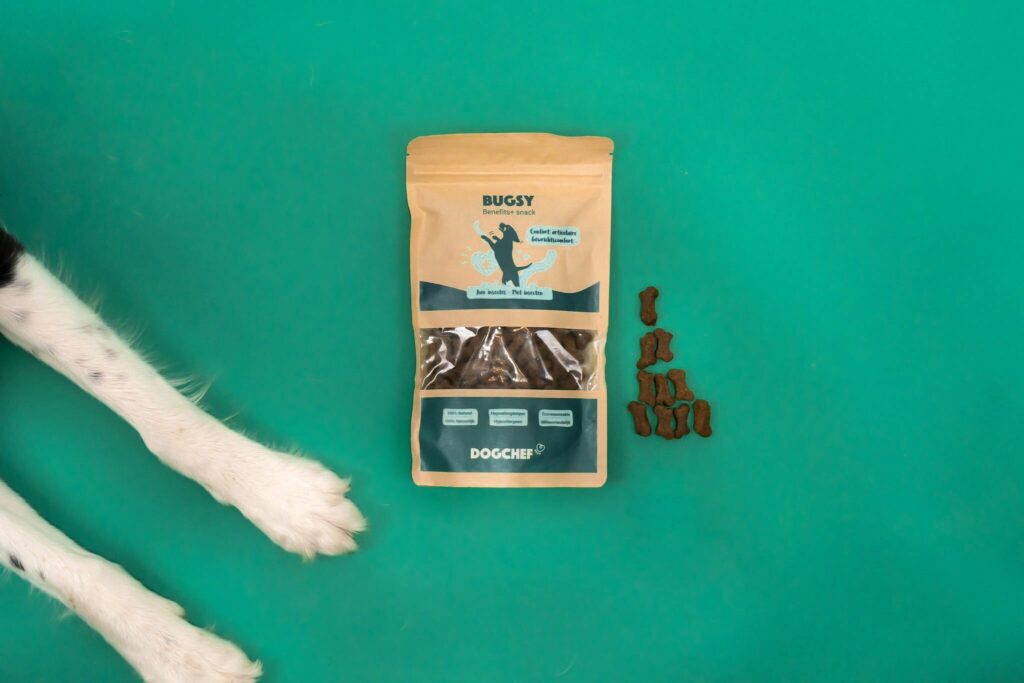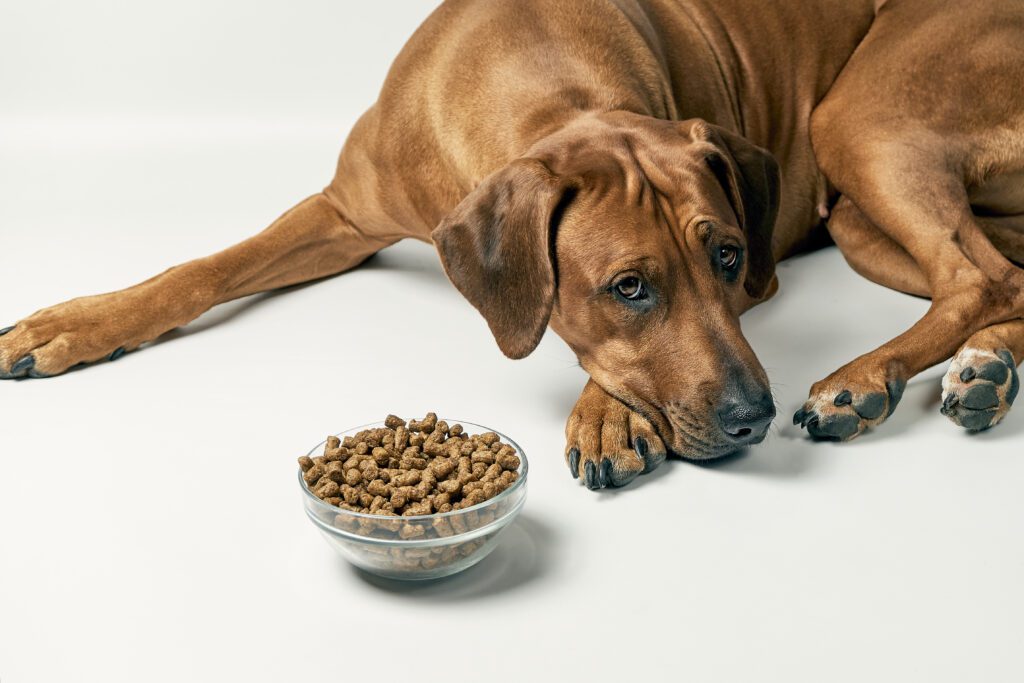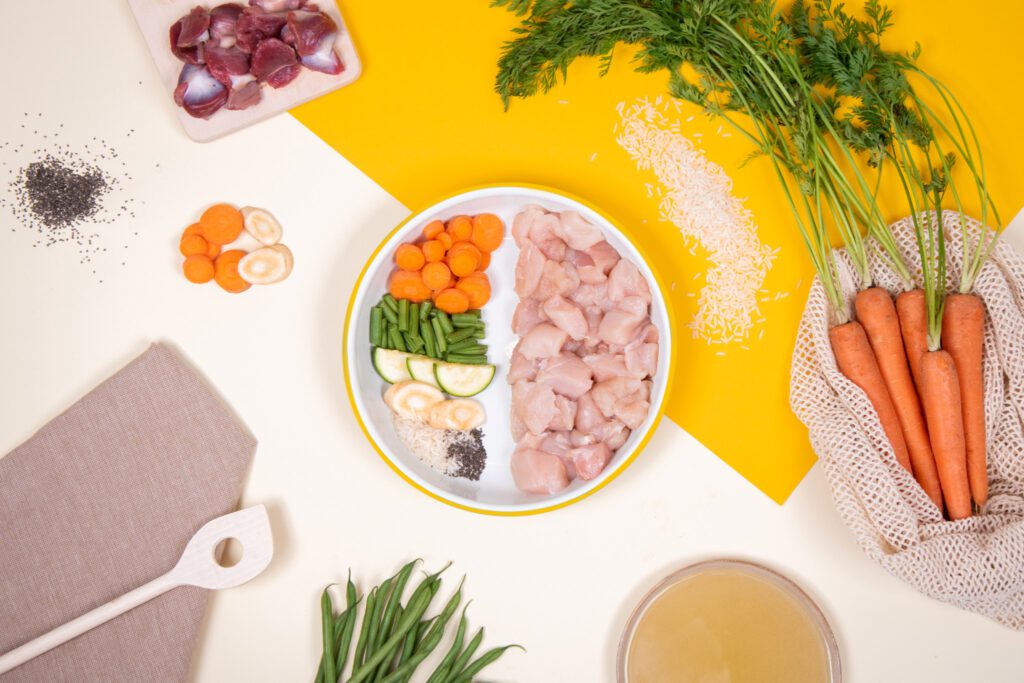Dogs adore to eat. Whether they’re throwing puppy eyes at you from under the dinner table, or ogling that mouldy pizza crust on the sidewalk: sometimes it seems like they live only to eat. That’s why it can be quite shocking to discover that your puppy suddenly no longer shows interest in food.
Healthy adult dogs can easily live 48 hours without ingesting food. Small breeds and newly weaned puppies only survive 8 hours without its valuable nutrients. If your dog skips a meal, you should not immediately worry that he will starve. However, sometimes your dog not eating is a symptom of an underlying problem. Use this checklist to determine whether your dog needs urgent medical attention.
1. Check your dog’s teeth
Do you notice blood, a broken, a loose or rotten teeth, inflamed gums, injuries or swelling in your dog’s mouth? Then your dog may find himself in too much pain to eat. Make an appointment with the vet as soon as possible to get the problem resolved. Reduce your dog’s dental pain while eating by serving canned food, soaked kibble or fresh meals.
2. Examine your dog’s body
Monitor and feel your dog’s body. Look for:
Make sure to also measure your dog’s temperature. The normal temperature of a dog is 38 to 39°C. Do you notice anything suspicious on your dog’s body or is his temperature too high or too low? Do not hesitate to contact a veterinarian.
3. Observe your dog’s behaviour
Are you noticing remarkable changes in your dog’s behaviour? Does it seem like he’s in pain or feels an itch? Does it look as though he’s lifeless or is he hiding? Behavioural changes often reveal that something is critically wrong with your dog. Ask the vet for advice.
4. Check your dog’s bowel movement
Is your dog constipated or does he suffer from diarrhea? Call the vet if the problem persists for more than 48 hours. Is there blood in his stool or do you think your dog may have ingested a strange object, medication, or chemical? Then call immediately!
5. Check if your dog is still drinking
Your dog who doesn’t drink is much more dangerous than your dog who refuses to eat. Even large adult dogs can run into trouble after 24 hours without water. Do you notice that your dog has stopped drinking? Get help right away to prevent dehydration.
Your adult dog doesn’t eat, but does keep on drinking? Then you can easily wait up to 48 hours before consulting a vet. Dogs under six months should see a vet within twelve hours while puppies and small breeds should be examined within eight hours. In the meantime, you can try to figure out for yourself what’s going on. This checklist will help:
1. Is something wrong with your dog’s diet?
Check the expiration date, colour and smell of your dog’s food. If you suspect the food has gone bad, throw it away and serve your dog something else to savour.
2. Has your dog eaten yet?
Has your dog been staying over at a friend’s or relative’s house? Then ask if they might have already served your dog a delicious meal. Maybe you gave your dog more snacks than you expected? In that case, you should consider that he simply lost his appetite. Owners often underestimate how much supplementary food they give their dog, especially if it comes to small breeds. A few dog biscuits quickly become a whole meal for a Dachshund or Pomeranian.
3. Does your dog enjoy too many snacks?
If your dog turns his nose up at kibble, but can be found for other treats, there is nothing to worry about. Be mindful that your dog is only very smart: he knows that you will offer him something more delicious in case he doesn’t touch his food. So one – zero for Oscar.
Dog Chef developed five delicious meals for smart dogs like Oscar: one with chicken, one with beef, one with duck, one with fish and one with pork. All rigorously tested and approved by the pickiest of eaters.
Did you know? Some breeds are naturally picky eaters. Poodles find just about anything more interesting than what you put in their bowls, especially when they’re young. Labradors and beagles are true omnivores.
4. How old is your dog?
When your dog is developing an eating disorder, you should take his age into account. These problems may be age-related. Just think of the changing of the teeth, puberty, and the third age.
Switching time
When your dog reaches the age of 3 to 7 months old, he will switch teeth. His permanent teeth keep pressing his milk teeth this hard, they eventually fall out. Such natural action causes pain, especially while eating. It may even cause your dog to eat less for a while. Temporarily switch to softer food like soaked kibble, canned food or fresh meals to prevent this kind of pain.
Puberty
Your dog enters puberty when he is 6 to 7 months old. Officially, this puberty lasts until your dog is an adult, anywhere from 1 to 1.5 years. During this period, there is a lot going on in your dog’s body. Sometimes he doesn’t even find time to eat! This can cause him to skip a meal, but that’s something you should not worry about.
Third age
As your dog gets older, his muscle mass decreases. Result? He needs less food to maintain it, so it is perfectly normal for an older dog to eat a little less. You therefore shouldn’t worry as long as his body weight stagnates.
Is your senior losing weight? Then it is important to find out why. Older dogs are more likely to have dental problems, but other age-related ailments such as dementia and joint pain can also lead to your dog decreasing appetite.
5. Has your dog been recently vaccinated?
Most vaccines contain a weakened or killed form of a virus or bacteria. Your dog’s immune system will object itself against components, causing your dog to feel unwell for a while. Don’t worry if he doesn’t immediately feel like eating. His appetite normally returns after a day or two.
6. Does your dog experience stress?
Stress can also cause your dog to eat less or not at all. These are the main causes of stress in dogs:
Separation anxiety
Does your dog whine or bark the minute you emerge from your house? Can’t your dog hold his water the instant you get home? Does he only eat when you’re around? Then he probably suffers from separation anxiety. With the right training, lots of love and even more patience you can help him get rid of it.
Changes in their lives
If you’re lucky, your dog has a problem with a small change that you can easily reverse. For example, by using a different food bowl, feeding your dog at a different time or feeding your dog in a different room. Unfortunately, some changes are determinant and more definitive. They could play a crucial role in your dog’s appetite. Think, for example, of the arrival of a new family member (human or animal) or the relocation of your daughter moving into a student room. Just be extra kind to your dog and try to stimulate his appetite with the tips below.
Do you have a picky eater living in your home? No worries, you can still enjoy a delicious meal following these tips:
1. Feed your dog fewer snacks
If you provide your dog with many snack options, it kind of makes sense that his appetite for kibble will disappear. In addition, dogs that are served snacks when they don’t eat, assume that they are rewarded when they don’t eat. Therefore, only give your dog snacks as a reward for good behaviour.
2. Offer a healthy, versatile diet to your dog
Variety is the spice of life. That’s no different with dogs. Changing your dog’s diet once in a while is not only good for your dog’s appetite, it also includes all types of ingredients enriched with the vitamins and minerals your dog needs.
Attention! Are you changing brands or are you switching from chunks to canned food or vice versa? Then do it gradually to make sure your dog’s body is given sufficient time to adapt.
3. Add water, stock, yogurt or canned food to dry kibble
Most dogs think dry kibble is rather… dry. They have little smell and the taste is only released during chewing. Adding water to the kibble releases the aromas faster, stimulating your dog’s senses.
Moreover, adding water does not only makes the chunks tastier, it also makes them softer. This can be very advantageous for dogs encountering dental problems. Think of puppies that are changing teeth or seniors that are missing teeth. Stock, yogurt or canned food are also perfect ingredients to make dry chunks softer and tastier.
4. Make sure your dog’s water bowl is filled while eating
Your dog is unlikely to take another bite if his throat is filled with dry kibble while there’s no water around. Make sure your dog’s water bowl is always filled so that he can drink the water to swallow food. The lower the moisture level in the nourishment, the more water your dog needs.
5. Serve your dog fresh meals from Dog Chef
Do you know what your dog loves even more than canned food? The fresh meals of Dog Chef! They are filled with healthy ingredients, prepared just like you would at home. Even the pickiest eaters come out of their basket for this.
6. Serve slightly warm food
You’ll release a wide array of aroma’s by simply slightly warming up your dog’s food. Your dog’s nose is activated and tells his stomach it’s dinner time!
7. Take your dog for a walk or a run before dinner time
Your dog’s body wants to replenish the energy he burns when it’s been moving. It sends stimuli to the brain that stimulate its appetite. So the more your dog moves now, the larger his appetite.
Your dog also builds muscle mass during exercise, which makes his metabolism work faster. That is, he needs more calories to maintain his body vital. A dog that moves a lot will therefore be more hungry than a dog that moves little, even on days when it is sitting still.
8. Reward your pooch while eating
Most dogs do not need encouragement to finish their food bowl. Do you notice that your dog does have an urgent need for that encouragement? Then reward your dog with words while he’s eating with sentences like: “Good. Good boy!’ This kind of pep talk will build his self-confidence, so that after a while he will no longer need you during dinner.
9. Feeding the dog by hand
Feeding from the owner’s hands will give the dog more successful opportunities to eat. This is partly related to the idea that they adore the attention, and partly due to dogs being programmed to please their owners. However, we do not advise you to feed your healthy dog by hand. Dogs get used to it very quickly, so they will soon get used to being fed by hand. You should only consider it if your dog is really sick and nothing else is working.
We could link your dog not wanting to eat to 101 reasons: he could be sick, have a toothache, or even have an earache. He may be scared or just having a bad day. Unfortunately, he can’t tell you that. That is annoying, because you want your best friend to always be his chipper self. Just keep in mind that a loss of appetite is no reason to panic straight away, but you may be well advised to take all signals seriously.



Votre navigateur est obsolète!
Mettez à jour votre navigateur pour afficher correctement ce site Web. Download Google Chrome